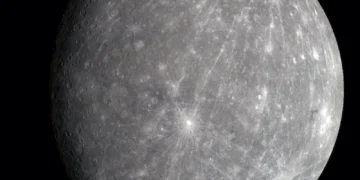Mercury, the smallest and closest planet to the Sun, has long puzzled astronomers. Despite its seemingly simple rocky appearance, its formation story remains one of the greatest mysteries in planetary science. Scientists have now proposed a new theory that suggests Mercury was formed through a massive planetary collision, challenging previous assumptions about how inner planets evolve.
Understanding Mercury’s Unusual Characteristics
Mercury’s structure and composition set it apart from other terrestrial planets. Unlike Earth, Venus, and Mars, Mercury has an unusually large iron core, making up about 70% of its total mass. This has led researchers to believe that the planet must have undergone a unique formation process, potentially involving a massive impact that stripped away much of its original rocky material.
The planet also experiences extreme temperature variations, with daytime temperatures soaring to 430°C and nighttime plunging to -180°C. Despite being the closest planet to the Sun, Mercury still has ice in permanently shadowed craters near its poles, adding to its enigmatic nature. Scientists have been searching for an explanation that accounts for these characteristics, and recent research suggests a new theory—one that rewrites our understanding of Mercury’s past.
The Collision Hypothesis: A New Perspective
A recent study led by Patrick Franco and his team at the National Observatory in Brazil proposes that Mercury formed through a high-energy collision between two similarly sized protoplanets. Unlike earlier theories that suggested Mercury resulted from a giant impact with a much larger body, this model argues that two nearly equal-mass objects collided, leading to the removal of much of the lighter material, leaving behind a dense iron-rich core.
Using advanced computer simulations, the researchers tested various impact scenarios by adjusting factors such as impact velocity, angle, and the composition of colliding bodies. Their goal was to recreate a planet with a mass and structure similar to modern Mercury. The simulations revealed that a high-velocity, grazing impact was the most likely explanation for Mercury’s formation, stripping away much of the mantle material while preserving a significant iron core.
How the Simulations Work
The research team ran three major simulations:
- The first simulation tested standard impact conditions but failed to produce a Mercury-like planet.
- The second simulation increased the impact velocity and adjusted the collision angle to make it more destructive. The results were promising but still not perfect.
- The third simulation refined these conditions further, carefully controlling parameters such as impactor mass, composition, and angle. This produced a planetary remnant that closely matched Mercury’s observed mass and core fraction, with an accuracy within 5% of the real planet’s values.
These findings suggest that high-energy impacts involving objects of similar size were more common in the early solar system than previously thought. This has significant implications not only for Mercury’s origin but also for our understanding of planetary formation across the inner solar system.
Why This Discovery Matters
This new theory sheds light on several long-standing mysteries about Mercury’s composition and evolution. It supports the idea that giant impacts played a major role in shaping the inner planets, particularly in determining their core-to-mantle ratios. It also challenges previous assumptions that Mercury formed in its current state, suggesting instead that it evolved through catastrophic collisions.
Furthermore, the study highlights how Mercury’s formation may have influenced other celestial bodies. Scientists believe that similar high-energy impacts could have contributed to the formation of Earth’s Moon, Venus’s thick atmosphere, and Mars’s geological features.
Comparisons with Other Celestial Collisions
Mercury is not the only planetary body believed to have undergone a major collision event. Earth’s Moon is thought to have formed from a massive impact between a Mars-sized body (Theia) and early Earth, ejecting material that later coalesced into the Moon. Similarly, Venus’s thick and toxic atmosphere may be the result of past collisions that altered its surface and atmospheric composition.
What makes Mercury’s case unique is the size and nature of the impact. Unlike the Moon’s formation, where a small object collided with a much larger one, Mercury’s creation involved two similarly sized protoplanets. This scenario is relatively rare but not impossible, and the new simulations provide strong evidence supporting this model.
Implications for Exoplanet Research
The findings on Mercury’s formation have implications beyond our solar system. Many exoplanets—planets orbiting other stars—have been found with extreme compositions, including super-Earths with iron-rich cores and unusual densities. If Mercury’s formation resulted from a high-energy collision, similar processes might have shaped exoplanets in other star systems.
Astronomers can now use this new model to refine their understanding of how rocky planets evolve under different conditions. By studying exoplanets with similar density and structure to Mercury, researchers can test whether high-energy collisions are a common mechanism in planetary formation across the universe.
What’s Next for Mercury Research?
NASA and ESA’s BepiColombo mission is currently on its way to Mercury, set to arrive in 2025. This spacecraft will provide unprecedented data on Mercury’s composition, magnetic field, and surface geology. By studying Mercury up close, scientists will be able to test the collision hypothesis and gather crucial evidence that could confirm or refine this new theory.
BepiColombo’s instruments will analyze Mercury’s surface composition, looking for signs of material distribution that would indicate a past impact event. The mission will also study Mercury’s core and magnetic field, providing deeper insights into the planet’s interior structure and thermal history.
Conclusion: A New Chapter in Mercury’s Story
The mystery of Mercury’s origin has fascinated scientists for decades, and this new theory offers an exciting breakthrough. The idea that Mercury formed through a violent collision between two similarly sized protoplanets challenges previous models and provides a plausible explanation for its unusual density and composition.



















